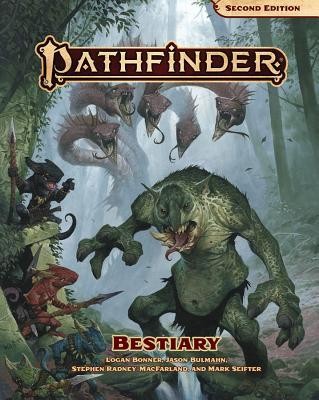Jürgen Hubert reviewed Pathfinder Bestiary by Paizo
A Declaration of Indepencence
5 stars
I remember the first Bestiary for the first edition of Pathfinder, which largely covered the same monsters as the D&D 3.5 Monster Manual. The first Bestiary for the second edition, however, boldly declares its independence from its Dungeons & Dragons roots. The mechanics are completely different, of course - but so is the monster lineup, which delves into the lore of Pathfinder's Inner Sea setting (including some small sidebars expanding the lore further).
From the various alghollthu species (kin of the aboleth) to the aeons, the cosmic enforcers of Order; from psychopomps to sinspawn - most of these will be familiar to veteran Pathfinder players, but not to those who are only familiar with the various incarnations of D&D. Nevertheless, old and familiar faces are present aplenty, whether the many-hued types of dragons, classical types of demons, devils, and giants, and so forth (although you can expect some changes …
I remember the first Bestiary for the first edition of Pathfinder, which largely covered the same monsters as the D&D 3.5 Monster Manual. The first Bestiary for the second edition, however, boldly declares its independence from its Dungeons & Dragons roots. The mechanics are completely different, of course - but so is the monster lineup, which delves into the lore of Pathfinder's Inner Sea setting (including some small sidebars expanding the lore further).
From the various alghollthu species (kin of the aboleth) to the aeons, the cosmic enforcers of Order; from psychopomps to sinspawn - most of these will be familiar to veteran Pathfinder players, but not to those who are only familiar with the various incarnations of D&D. Nevertheless, old and familiar faces are present aplenty, whether the many-hued types of dragons, classical types of demons, devils, and giants, and so forth (although you can expect some changes among these as well).
On the mechanics side, the creatures make good use of Pathfinder 2E's three action economy, and most have plenty of interesting and flavorful combat options. That even includes "ordinary" animals, which will now feel much more distinct than in previous options. There are also quite a few useful suggestions on how to transform ordinary people and creatures into supernatural creatures (whether zombies or werewolves), although they should be seen as guidelines rather than fixed "suggestions".
I have only two real quibbles with this book, one minor and one major. First, a lot of stat blocks featuring variants of the same creature type refer to earlier stat blocks. For example, the "Azure Worm" stat block has the following:
"Thrash [two-actions] As purple worm."
I prefer stat blocks to be complete in themselves, without having to refer to other pages during play.
Which brings me to my second problem: Creatures that are able to cast spells. Here, too, you only get the name of the spell, but to understand what the spell actually does, you have to look it up in an entirely different book.
Apart from these, this book does what it sets out to do, and does it well - and thus it is an invaluable addition for any Pathfinder 2E game master.

